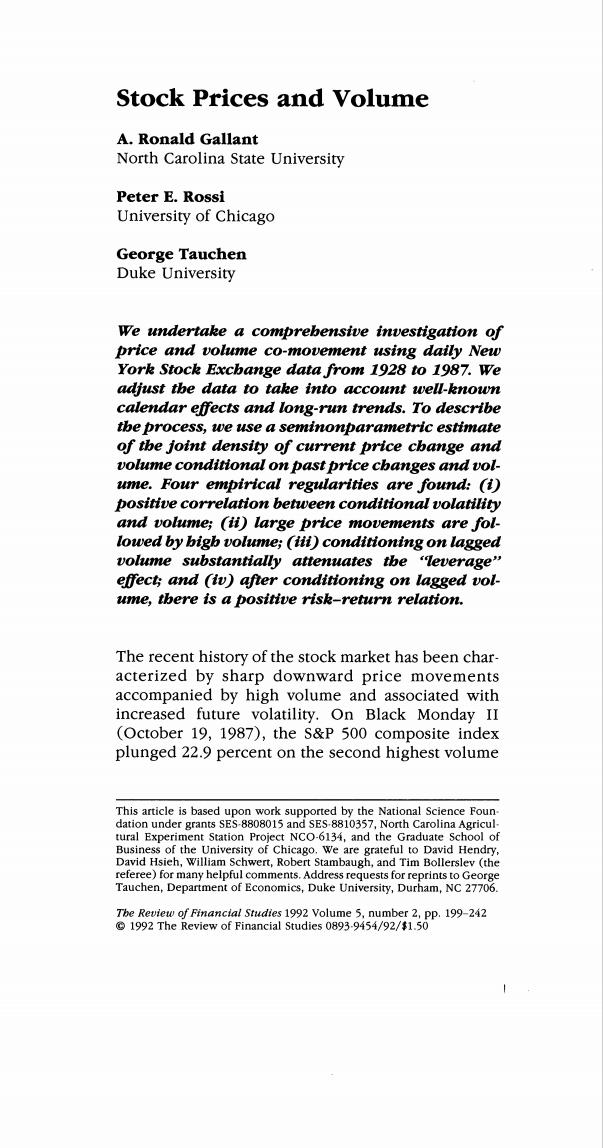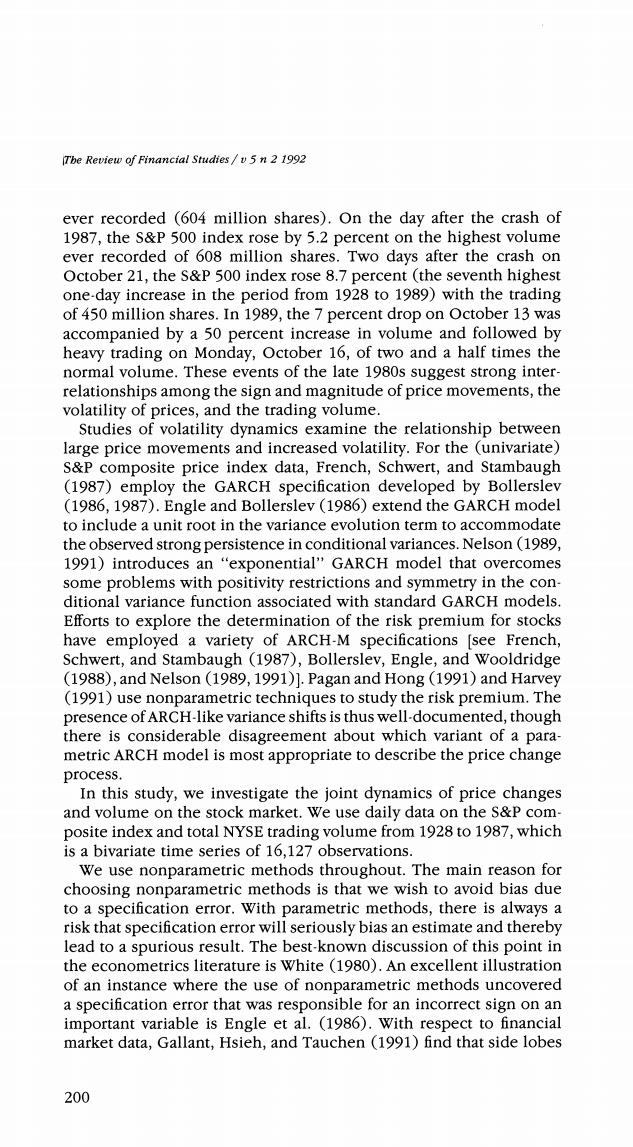
Stock Prices and Volume STOR A.Ronald Gallant;Peter E.Rossi;George Tauchen The Review of Financial Studies,Volume 5,Issue 2 (1992).199-242 Stable URL: hutp://links.jstor.org/sici?sici=0893-9454%281992%295%3A2%3C199%3ASPAV3E2.0.CO%3B2-Y Your use of the JSTOR archive indicates your acceptance of JSTOR's Terms and Conditions of Use,available at http://www.jstor.org/about/terms.html.JSTOR's Terms and Conditions of Use provides,in part,that unless you have obtained prior permission,you may not download an entire issue of a journal or multiple copies of articles,and you may use content in the JSTOR archive only for your personal,non-commercial use. Each copy of any part of a JSTOR transmission must contain the same copyright notice that appears on the screen or printed page of such transmission. The Review of Financial Studies is published by Oxford University Press.Please contact the publisher for further permissions regarding the use of this work.Publisher contact information may be obtained at http://www.jstor.org/journals/oup.html. The Review of Financial Studies 1992 Oxford University Press JSTOR and the JSTOR logo are trademarks of JSTOR,and are Registered in the U.S.Patent and Trademark Office. For more information on JSTOR contact jstor-info@umich.edu. ©2003 JSTOR http://www.jstor.org/ Mon Feb1708:55:332003

Stock Prices and Volume A.Ronald Gallant North Carolina State University Peter E.Rossi University of Chicago George Tauchen Duke University We undertake a comprebensive investigation of price and volume co-movement using daily New York Stock Excbange data from 1928 to 1987.We adjust tbe data to take into account well-known calendar effects and long-run trends.To describe the process,we use a seminonparametric estimate of the joint density of current price change and volume conditional on past price changes and vol- ume.Four empirical regularities are found:(i) positive correlation between conditional volatility and volume;(ii)large price movements are fol- lowed by bigb volume;(iii)conditioning on lagged volume substantially attenuates the 'leverage" effect;and (iv)after conditioning on lagged vol- ume,tbere is a positive risk-return relation. The recent history of the stock market has been char- acterized by sharp downward price movements accompanied by high volume and associated with increased future volatility.On Black Monday II (October 19,1987),the s&P 500 composite index plunged 22.9 percent on the second highest volume This article is based upon work supported by the National Science Foun dation under grants SES-8808015 and SES-8810357,North Carolina Agricul- tural Experiment Station Project NCO-6134,and the Graduate School of Business of the University of Chicago.We are grateful to David Hendry, David Hsieh,William Schwert,Robert Stambaugh,and Tim Bollerslev (the referee)for many helpful comments.Address requests for reprints to George Tauchen,Department of Economics,Duke University,Durham,NC 27706. The Review of Financial Studies 1992 Volume 5,number 2,pp.199-242 1992 The Review of Financial Studies 0893-9454/92/$1.50

The Review of Financial Studies /v 5 n 2 1992 ever recorded (604 million shares).On the day after the crash of 1987,the S&P 500 index rose by 5.2 percent on the highest volume ever recorded of 608 million shares.Two days after the crash on October 21,the S&P 500 index rose 8.7 percent (the seventh highest one-day increase in the period from 1928 to 1989)with the trading of 450 million shares.In 1989,the 7 percent drop on October 13 was accompanied by a 50 percent increase in volume and followed by heavy trading on Monday,October 16,of two and a half times the normal volume.These events of the late 1980s suggest strong inter- relationships among the sign and magnitude of price movements,the volatility of prices,and the trading volume. Studies of volatility dynamics examine the relationship between large price movements and increased volatility.For the (univariate) S&P composite price index data,French,Schwert,and Stambaugh (1987)employ the GARCH specification developed by Bollerslev (1986,1987).Engle and Bollerslev (1986)extend the GARCH model to include a unit root in the variance evolution term to accommodate the observed strong persistence in conditional variances.Nelson (1989, 1991)introduces an "exponential"GARCH model that overcomes some problems with positivity restrictions and symmetry in the con- ditional variance function associated with standard GARCH models. Efforts to explore the determination of the risk premium for stocks have employed a variety of ARCH-M specifications [see French, Schwert,and Stambaugh (1987),Bollerslev,Engle,and Wooldridge (1988),and Nelson(1989,1991)].Pagan and Hong (1991)and Harvey (1991)use nonparametric techniques to study the risk premium.The presence of ARCH-like variance shifts is thus well-documented,though there is considerable disagreement about which variant of a para- metric ARCH model is most appropriate to describe the price change process. In this study,we investigate the joint dynamics of price changes and volume on the stock market.We use daily data on the S&P com- posite index and total NYSE trading volume from 1928 to 1987,which is a bivariate time series of 16,127 observations. We use nonparametric methods throughout.The main reason for choosing nonparametric methods is that we wish to avoid bias due to a specification error.With parametric methods,there is always a risk that specification error will seriously bias an estimate and thereby lead to a spurious result.The best-known discussion of this point in the econometrics literature is White (1980).An excellent illustration of an instance where the use of nonparametric methods uncovered a specification error that was responsible for an incorrect sign on an important variable is Engle et al.(1986).With respect to financial market data,Gallant,Hsieh,and Tauchen (1991)find that side lobes 200

Stock Prices and Volume in the error density (which are ruled out in customary,parametric, ARCH specifications)are clearly revealed in a nonparametric analysis and are the apparent source of spurious findings of nonlinearity over and above ARCH.Engle and Gonzales-Rivera (1991)analyze these same data using an alternative nonparametric technique.They confirm these departures from customary parametric specifications and per- form Monte Carlo simulations to assess the consequences for para- metric analysis. Previous empirical work on the price and volume relationship has focused primarily on the contemporaneous relationship between price changes and volume.Transactions level,hourly,daily,weekly,and monthly data on individual stocks,futures,and stock price indices have been used to document a positive correlation between the abso- lute value of stock price changes and volume [see Karpoff(1987)and Tauchen and Pitts (1983)for summaries of this literature].Foster and Viswanathan (1990)use transactions level data to examine within- day price-volume relations;Mulherin and Gerety (1988)use both hourly and daily volume and returns data to document the relation- ship between the magnitude of price changes and volume,as well as patterns in volume by time of day and week for the period from 1900 to 1987.Lamoureux and Lastrapes (1991)enter volume directly into the GARCH variance equation in their analysis of individual stock returns data.Schwert (1989)uses monthly aggregates of daily data and finds a positive relationship between estimated volatility and current and lagged volume growth rates in linear distributed lag and VAR models.With the exception of Mulherin and Gerety (1988),most empirical studies using daily or within-day data examine relatively short time periods of between 3 and 5 years. Generally speaking,the empirical work on price-volume relations tends to be very data-based and not guided by rigorous,equilibrium models of market behavior.The models are more statistical than economic in character,and typically neither the optimization prob- lem facing agents nor the information structure is fully specified.The intrinsic difficulties of specifying plausible,rigorous,and imple- mentable models of volume and prices are the reasons for the informal modeling approaches commonly used. Recently,some interesting theoretical work investigated factors such as heterogeneous agents and incomplete markets,which are substantial complications of the familiar representative agent asset- pricing models.For example,Admati and Pfleiderer (1988,1989) explore the implications for within-day and weekend volume and price movements of a model comprised of informed traders and liquidity traders.Huffman (1987)presents a capital growth model with overlapping generations that yields a contemporaneous volume- 201

Tbe Review of Financial Studies /v 5 n 2 1992 price relationship.More recently,Huffman (1988)and Ketterer and Marcet (1989)examine trading volume and welfare issues in various economies comprised of heterogeneous infinitely lived agents facing limited trading opportunities [also,see Andersen (1991)].Existing models,however,do not confront the data in its full complexity and have not evolved sufficiently to guide the specification of an empirical model of daily stock market data.For instance,there seems to be no model with dynamically optimizing,heterogeneous agents that can jointly account for major stylized facts-serially correlated volatility, contemporaneous volume-volatility correlation,and excess kurtosis of price changes-each of which we discuss below. In this article,we undertake an empirical investigation of the dynamic interrelationships among price and volume movements on the stock market.Our work is motivated in part by the recent events on the stock market,which suggest that more can be learned about the market-and,in particular,about volatility-by studying prices in conjunction with volume,instead of prices alone.It is also moti- vated by an objective of providing a full set of stylized facts that theoretical work will ultimately have to confront.Because of the limitations of existing theory,the empirical work is not organized around the specification and testing of a particular model or class of models.Instead,the empirical effort is mainly data-based.We begin with an informal graphical look at the data and then proceed ulti- mately to the estimation and interpretation of a seminonparametric (SNP)model of the conditional joint density of market price changes and volume in Section 3. The investigation has four objectives:(i)to analyze the relation- ships between contemporaneous volume and volatility in an esti- mation context that explicitly accounts for conditional heteroskedas- ticity and other forms of conditional heterogeneity;(ii)to characterize the intertemporal relationships among prices,volatility,and volume; (iii)to examine the "leverage"effect,which is an asymmetry about the vertical axis in a plot of the conditional variance of current price change against past price change,and to examine the extent to which conditioning on past volume reduces or increases the asymmetry;and (iv)to determine what,if any,relationship there is between the conditional mean and variances of price changes. These objectives relate to features of the conditional density of the price change and volume data,and not to the signs and magnitudes of specific parameters.The conditional density is the fundamental statistical object of interest,as it embodies all of the information about the probabilistic structure of the data.Hence,as noted above,we employ a seminonparametric approach to estimate the density directly. 202